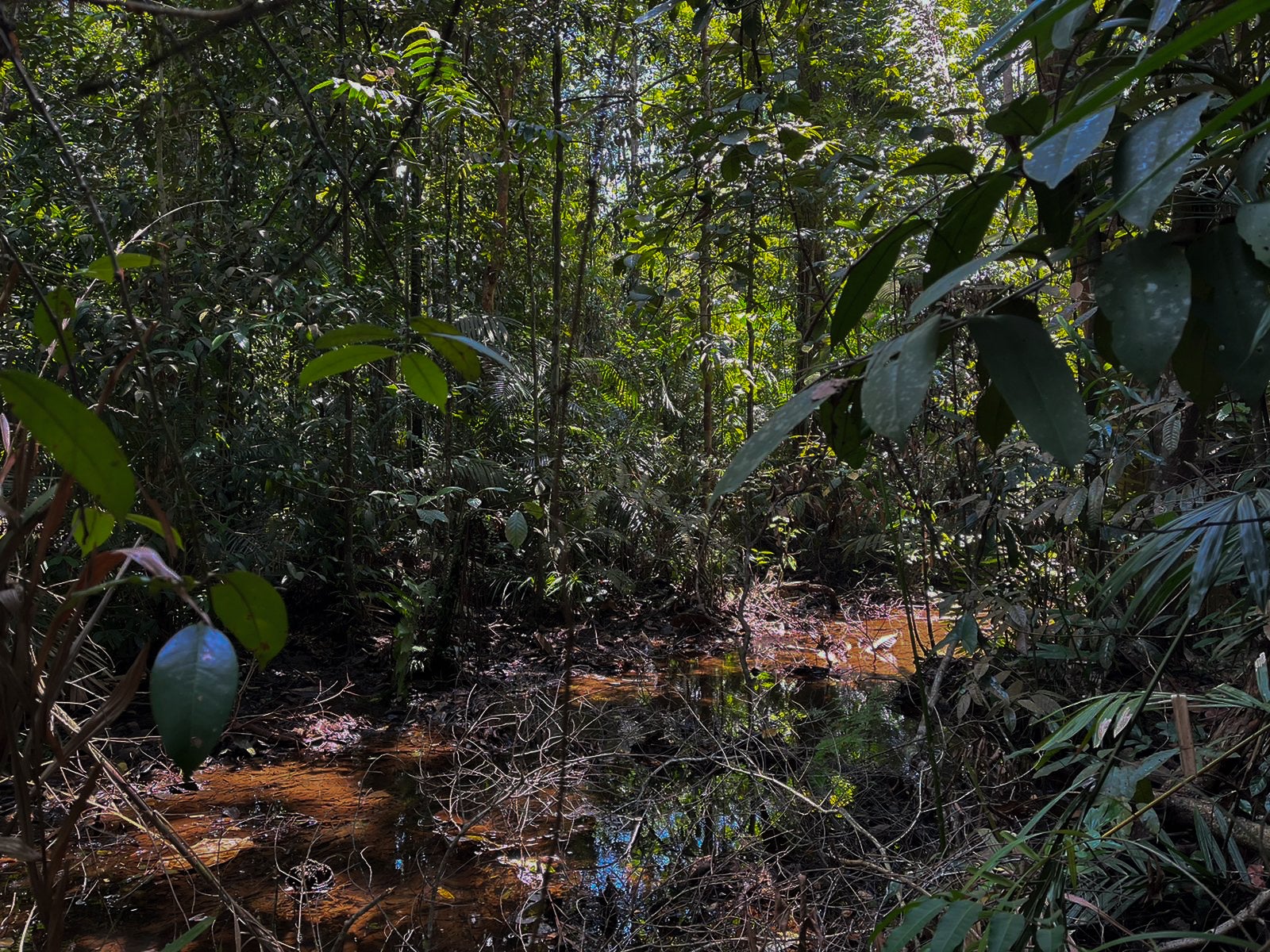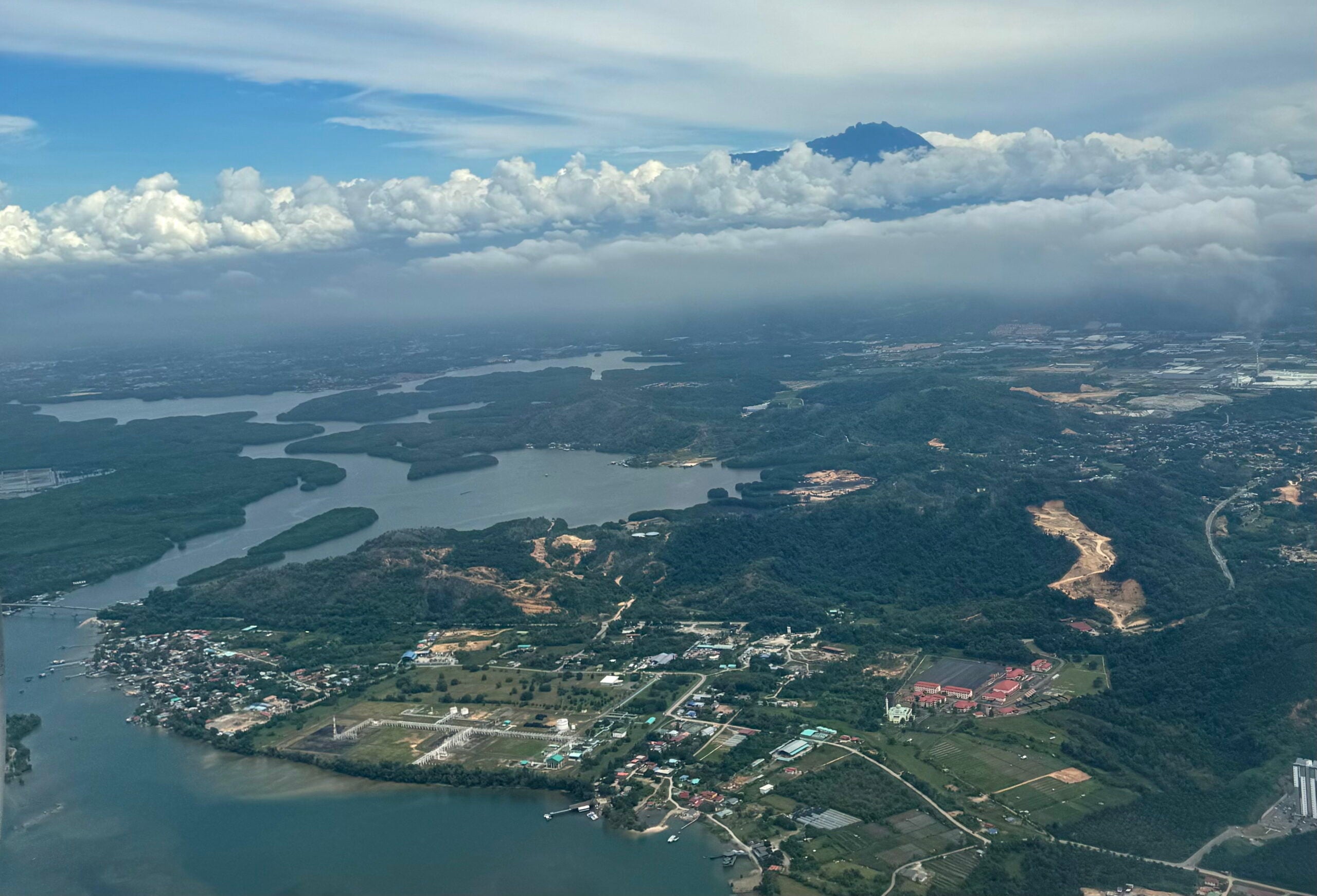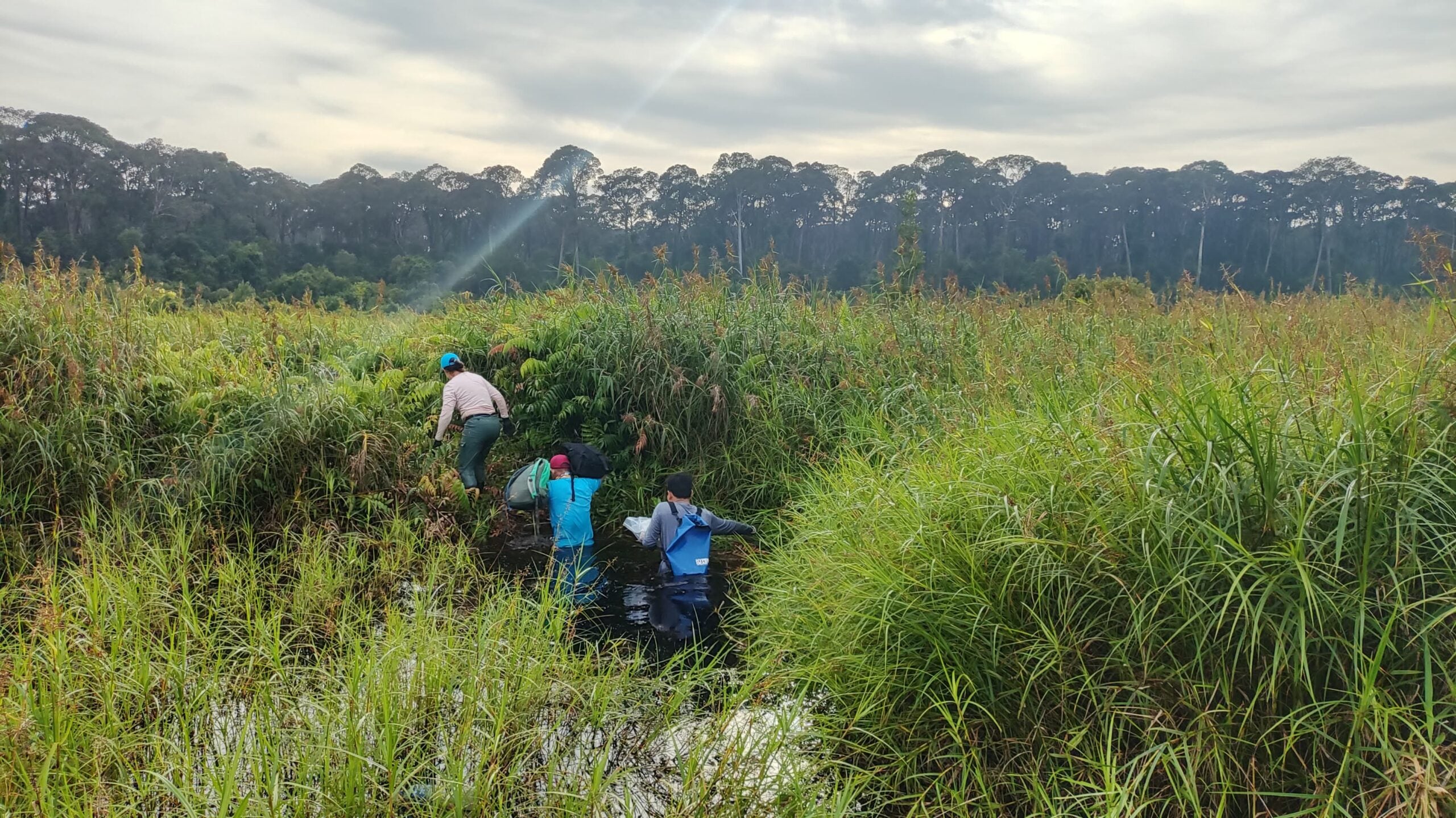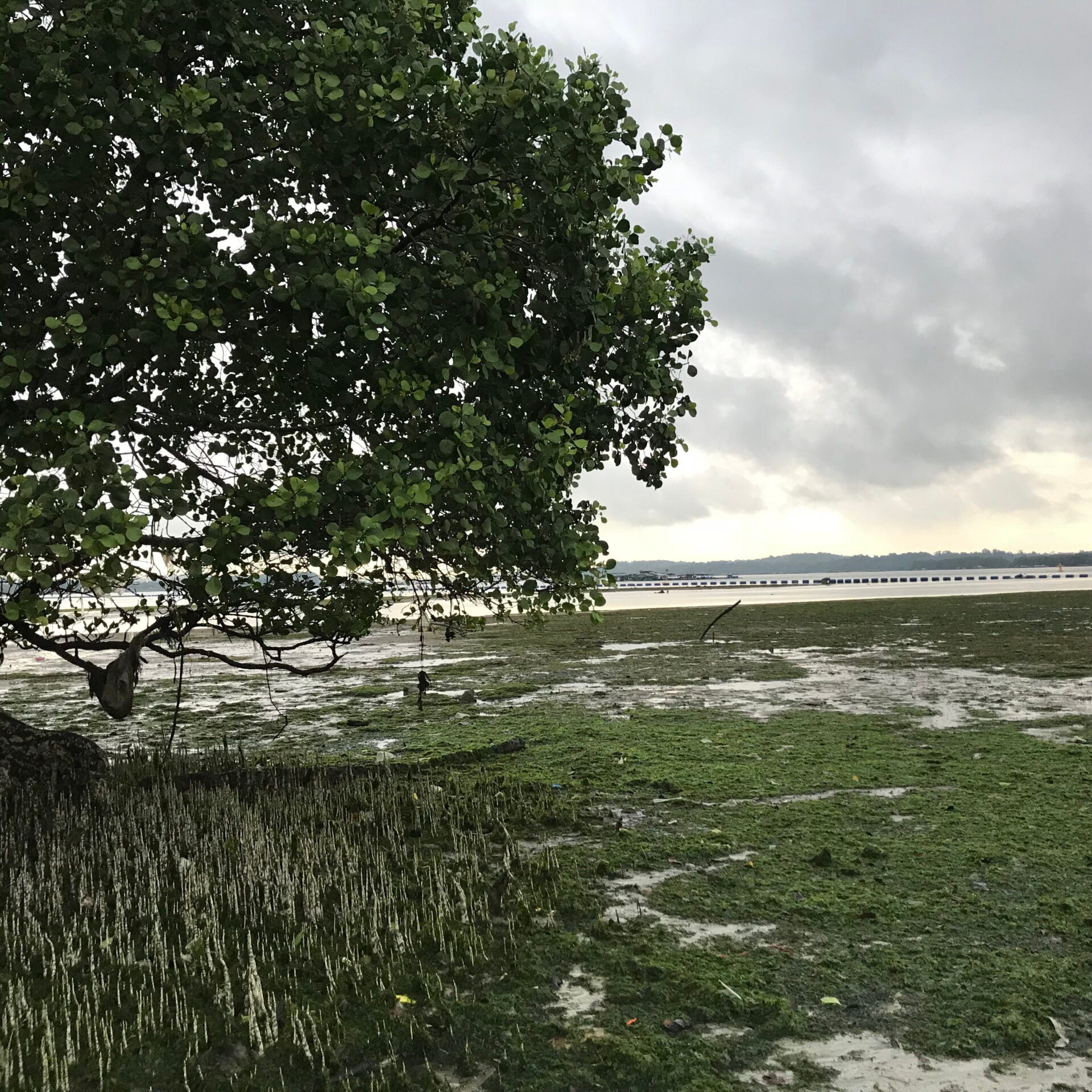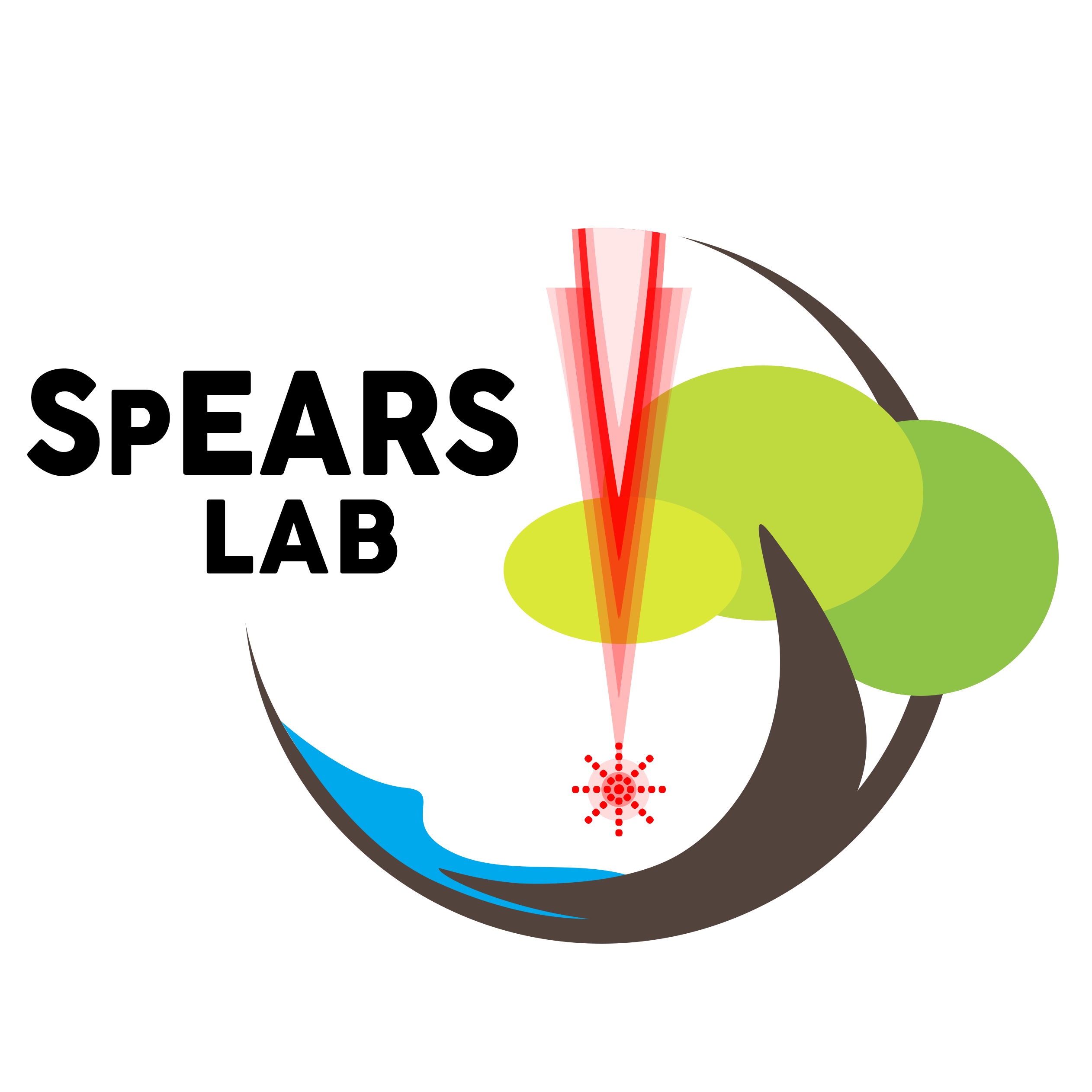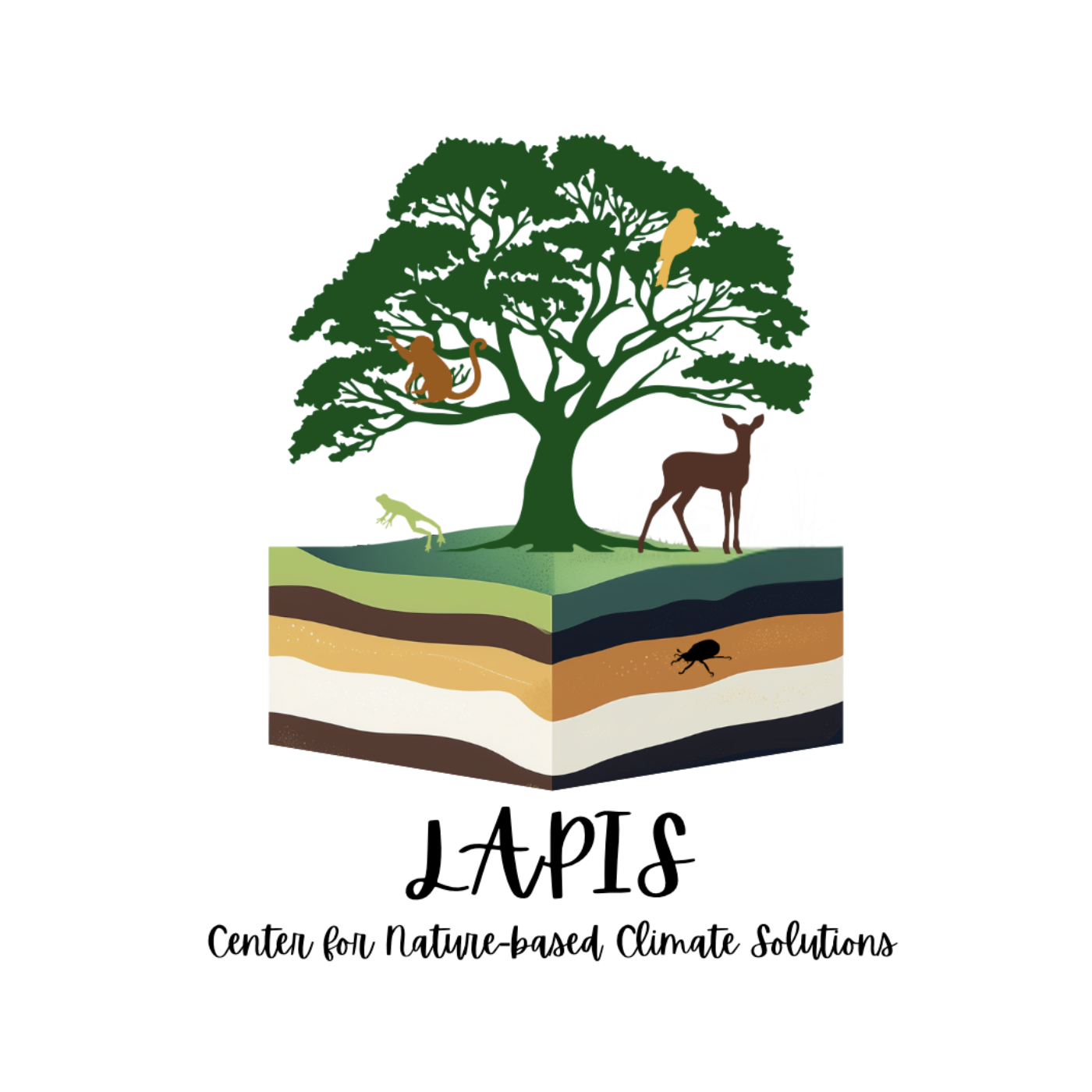-
Soil carbon as a blind spot in tropical rainforest restoration
Nadine Keller, Mark A. Anthony, Tessa S. van der Voort, Khairun Nisha Binte Mohamed Ramdzan, Maria B. Mills, Nanette C. Raczka, Lian Pin Koh
Current Biology
Tropical forests, long degraded, are now central to ecosystem restoration efforts like tree planting aimed at boosting aboveground biomass. However, the role of soil carbon storage—crucial to ecosystem carbon budgets—has been largely overlooked. This review explores how active restoration affects soil carbon across major tropical regions (Southeast Asia, Central Africa, and the Neotropics), highlighting pathways of carbon gain and loss. Findings suggest that increased biomass, biodiversity, and mycorrhizal associations can enhance soil carbon, while site preparation has minimal impact. Invasive species management may reduce soil carbon, though it's understudied. Despite often small changes, soil carbon shifts significantly influence carbon cycling and offsetting efforts. More targeted field research is needed in data-scarce tropical regions to inform restoration and carbon initiatives.
Published August 2025 -
Reduction of deforestation by agroforestry in high carbon stock forests of Southeast Asia
Hoong Chen Teo, Aakash Lamba, Sean J. W. Ng, Anh Tuan Nguyen, Adrian Dwiputra, Annabel Jia Yi Lim, Minh Nhat Nguyen, Pantana Tor-ngern, Yiwen Zeng, Sonya Dewi, Lian Pin Koh
Nature Sustainability
Agroforestry is widely practised for local social-economic and ecological co-benefits, however whether it is beneficial at landscape scale in terms of decreasing deforestation rates remains unclear. Using causal inference, we found local variability but an overall net reduction in deforestation attributed to agroforestry of 250,319 ha yr−1 or 58.8 ± 15.5 Mt CO2 equivalent per year across 38 subnational regions in Southeast Asia (P < 0.05), including high carbon stock forests and deforestation hotspots. These findings provide support and nuance for agroforestry as a natural climate solution especially in biodiverse Southeast Asian forests, which harbour high levels of carbon stocks.
Published March 2025 -
Accurate spaceborne waveform simulation in heterogeneous forests using small-footprint airborne LiDAR point clouds
Yi Li, Guangjian Yan, Weihua Li, Donghui Xie, Hailan Jiang, Linyuan Li, Jianbo Qi, Ronghai Hu, Xihan Mu, Xiao Chen, Shanshan Wei, Hao Tang
ISPRS Journal of Photogrammetry and Remote Sensing
Spaceborne LiDAR waveform sensors need accurate simulations for calibration, validation, and land data product development. Simulating waveforms over heterogeneous forests is difficult because data-driven methods ignore complex pulse transport, while analytical models rely on simplifying assumptions. This study introduces a new framework combining a canopy voxel radiative transfer (CVRT) model with 3D forest scenes from airborne LiDAR data. The CVRT model accounts for within-voxel heterogeneity using fractional crown cover, reducing assumptions and input needs. Evaluated against existing models, simulated and measured data, the framework showed 2–5% better agreement (R²) and 0.5–3% lower error (RMSE). It is robust across various conditions and improves large-footprint LiDAR waveform simulations, aiding future spaceborne LiDAR missions.
Published December 2024 -
Charting the future of high forest low deforestation jurisdictions
Hoong Chen Teo, Tasya Vadya Sarira, Audrey R. P. Tan, Yanyan Cheng, Lian Pin Koh
PNAS
This study highlights the importance of protecting high forest low deforestation jurisdictions (HFLDs) against future deforestation. Such deforestation could release substantial carbon into the atmosphere. Our findings have shown that it is insufficient to base market-based carbon financing on historical deforestation rates. Advances in baselining methods are necessary to achieve adequate market-based carbon financing. By using an empirical multifactorial model, we identify the HFLDs at the highest risk of future deforestation. This emphasizes the need for better baselines to protect these vital forests and mitigate the impact of deforestation on climate change.
Published September 2024 -
Conservation opportunities through improved management of recently established protected areas in Southeast Asia
Rachakonda Sreekar, Lian Pin Koh, Aakash Lamba, Christos Mammides, Hoong Chen Teo, Adrian Dwiputra, Yiwen Zeng
Current Biology
Protected areas (PAs) are vital for biodiversity and climate mitigation, but poor management can cause deforestation and carbon emissions. We analyzed 80 Southeast Asian PAs and found 36 prevented 78,910 ha of deforestation, while 44 lost 72,497 ha, threatening 226 species. Better managing these 44 PAs could avoid 2.07 MtCO2e yearly emissions, needing at least $17 million annually. Carbon markets could fund this. Improving PA management is key to biodiversity conservation and climate action.
Published August 2024 -
From beak to fruit: An Asian hornbill database for frugivory and seed dispersal research
Hanci Liang, Kim R. McConkey, Jun Ying Lim
Global Ecology and Conservation
Hornbills (Bucerotidae) are key frugivores and seed dispersers in Asian tropical forests. Despite local knowledge of their diets and seed dispersal roles, a comprehensive, standardized database was lacking. We compiled 2,365 records covering 26 of 32 Asian and New Guinea hornbill species, involving 471 plant species. However, data gaps remain, especially on seed fate post-consumption. About 58% of records indicate seed removal, but only 26% show seed deposition and 1% post-depositional viability. Our dataset highlights hornbills’ unique role in dispersing large seeds beyond other birds' capabilities, with a weak positive link between beak and seed size. More research is needed, and this database aims to support future studies.
Published March 2024 -
Technology-Driven Methods for Estimation of Nature-Based Carbon Stocks in Singapore
Khairun Nisha Binte Mohamed Ramdzan, Zu Dienle Tan, Leah Mary Lilly Denoun, H. Manjari Jayathilake, Annabel Jia Yi Lim, Yiwen Zeng, Hao Tang, Lian Pin Koh
Centre for Nature-based Climate Solutions, Faculty of Science, National University of Singapore
Final Report
Calculating forest carbon using forest inventory measurements can be laborious, mainly when conducted across an entire forest. As a result, reliance on traditional ground-based methods alone may not provide comprehensive forest information at a broad spatial scale. Instead, remote sensing technologies such as LiDAR (Light Detection and Ranging) and satellite imagery offer invaluable tools for gathering forest information, including tree heights and canopy structure, across vast landscapes. This project incorporated remote sensing technologies and field measurements to pave the way for a cost-effective means of surveying and monitoring nature-based carbon projects. It provides a preliminary estimate of carbon for different forest ecosystem types across Singapore and demonstrated the use of remote sensing technology for potential monitoring of forest aboveground carbon density (ACD). Further, the findings show that remote sensing technology can scale up field measurements and estimate spatially explicit carbon over a larger area. These carbon maps offer valuable insights into carbon sequestration potential, allowing stakeholders from diverse fields to make informed decisions on nature-based solution projects.
Published March 2024 -
Uncertainties in deforestation emission baseline methodologies and implications for carbon markets
Hoong Chen Teo, Nicole Hui Li Tan, Qiming Zheng, Annabel Jia Yi Lim, Rachakonda Sreekar, Xiao Chen, Yuchuan Zhou, Tasya Vadya Sarira, Jose Don T. De Alban, Hao Tang, Daniel A. Friess, Lian Pin Koh
Nature Communications
Carbon credits from jurisdictional avoided deforestation projects depend on accurate emission baselines, but these baselines face significant variability and uncertainty. Analyzing 2,794 jurisdictions, we found median baseline estimates varied by 171% and forecast errors averaged 0.778 times actual deforestation. The choice of deforestation projection method greatly influenced results, with 68% of methods exceeding 15% uncertainty. Tropical and polar regions showed higher uncertainties. Using sensitivity analyses and multi-model ensembles can reduce bias and variability, improving carbon market reliability.
Published December 2023 -
Intercomparison of Multiple High-Resolution LAI Remote Sensing Products Over Neon Forest Sites
Xiao Chen, Gaofei Yin, Shanshan Wei, Hoong Chen Teo, Guoxiang Liu, Hao Tang
IEEE
Leaf Area Index (LAI) is a key biophysical variable in ecosystem modeling. This study assessed the consistency and accuracy of high-resolution LAI products from NEON’s NIS, Sentinel-2 (S2), and GEDI lidar, comparing them to in-situ Digital Hemispheric Photos (DHPs) across 19 NEON forest sites in the U.S. At the plot level (~20m), agreements among remote sensing products were moderate (r² = 0.23–0.35), influenced by factors like geolocation errors and slope. However, site-level comparisons showed stronger correlations (r² = 0.59–0.76). GEDI aligned best with DHP estimates (r² = 0.53), outperforming NIS and S2 (r² = 0.33 and 0.30). Despite plot-level uncertainties, combining these products holds promise for improving regional LAI estimates.
Published October 2023 -
The neglected role of abandoned cropland in supporting both food security and climate change mitigation
Qiming Zheng, Tim Ha, Alexander V. Prishchepov, Yiwen Zeng, He Yin, Lian Pin Koh
Nature Communications
Despite growing land scarcity, cropland abandonment is widespread. Reusing abandoned cropland could enhance food security and mitigate climate change. Using spatial modeling and scenario analysis, we identify 101 Mha of abandoned cropland (1992–2020), capable of supporting 29–363 Peta-calories/year in food and mitigating 290–1,066 MtCO₂/year. Spatial prioritization and strategic land allocation are key to maximizing these benefits. Our findings highlight the potential of abandoned cropland for sustainable land management aligned with food and climate goals.
Published September 2023 -
Increasing contribution of urban greenery to residential real estate valuation over time
Hoong Chen Teo, Tze Kwan Fung, Xiao Ping Song, Richard N. Belcher, Kelly Siman, Ian Z.W. Chan, Lian Pin Koh
Sustainable Cities and Society
Urban development often reduces greenery, even as cities pursue greening efforts. Due to limited long-term data, the impact of land-use changes and policies on ecosystem services and greenery preferences remains unclear. Using high-resolution satellite imagery, we mapped land cover in Singapore from 1990 to 2020, revealing a decline in greenery within public housing towns but intensification in remaining green areas. Hedonic pricing analysis showed increasing real estate value linked to greenery: S$39,130 (9.2%) in the 1990s, S$46,049 (10.9%) in the 2000s, and S$50,048 (11.7%) in the 2010s. Preferences shifted toward tree cover over grass, highlighting how improved greenery quality can enhance urban ecosystem services even amid spatial decline.
Published September 2023 -
Climate co-benefits of tiger conservation
Aakash Lamba, Hoong Chen Teo, Rachakonda Sreekar, Yiwen Zeng, Luis Roman Carrasco, Lian Pin Koh
Nature Ecology & Evolution
Biodiversity conservation is increasingly being recognized as an important co-benefit in climate change mitigation programmes that use nature-based climate solutions. However, the climate co-benefits of biodiversity conservation interventions, such as habitat protection and restoration, remain understudied. Here we estimate the forest carbon storage co-benefits of a national policy intervention for tiger (Panthera tigris) conservation in India. We used a synthetic control approach to model avoided forest loss and associated carbon emissions reductions in protected areas that underwent enhanced protection for tiger conservation. Over a third of the analysed reserves showed significant but mixed effects, where 24% of all reserves successfully reduced the rate of deforestation and the remaining 9% reported higher-than-expected forest loss. The policy had a net positive benefit with over 5,802 hectares of averted forest loss, corresponding to avoided emissions of 1.08 ± 0.51 MtCO2 equivalent between 2007 and 2020. This translated to US$92.55 ± 43.56 million in ecosystem services from the avoided social cost of emissions and potential revenue of US$6.24 ± 2.94 million in carbon offsets. Our findings offer an approach to quantitatively track the carbon sequestration co-benefits of a species conservation strategy and thus help align the objectives of climate action and biodiversity conservation.
Published May 2023 -
Drivers of global mangrove loss and gain in social-ecological systems
Valerie Hagger, Thomas A. Worthington, Catherine E. Lovelock, Maria Fernanda Adame, Tatsuya Amano, Benjamin M. Brown, Daniel A. Friess, et al.
Nature Communications
This paper assesses the relationship between socioeconomic and biophysical variables and mangrove change across coastal geomorphic units worldwide from 1996 to 2016. Globally, this paper finds that drivers of loss can also be drivers of gain, and that drivers have changed over 20 years.
Published October 2022 -
Blue carbon science, management and policy across a tropical urban landscape
Daniel A. Friess, Yasmine M.Gatt, Tze Kwan Fung, Danwei Huang, Valerie Kwan, Kiah Eng, Lian Pin Koh, et al.
Landscape and Urban Planning
The ability of vegetated coastal ecosystems to sequester high rates of “blue” carbon over millennial time scales has attracted the interest of national and international policy makers as a tool for climate change mitigation. The experiences of Singapore show that coastal ecosystems and their blue carbon stocks can be successfully managed along an urban coastline, and can help inform blue carbon science and management along other rapidly urbanizing coastlines throughout the tropics.
Published October 2022 -
Cross-cutting research themes for future mangrove forest research
Farid Dahdouh-Guebas, Daniel A. Friess, Catherine E. Lovelock, Rod M. Connolly, Ilka C. Feller, Kerrylee Rogers, Stefano Cannicci
Nature Plants
This paper identified the function of mangrove ecosystems that underpin ecosystem services, their responses to extreme weather and climatic events, and their role as crucial social-ecological systems as important paradigms shaping mangrove research now and in times to come.
Published October 2022 -
Carbon Prospecting
Centre for Nature-based Climate Solutions & ST Engineering Geo-Insights
A new mapping tool to identify where natural ecosystems, like tropical forests and mangroves, can be conserved to help policymakers and investors identify potential sources of high-quality carbon credits.
Published September 2022 -
Large-scale reforestation can increase water yield and reduce drought risk for water-insecure regions in the Asia-Pacific
Hoong Chen Teo, Srivatsan V. Raghavan, Xiaogang He, Zhenzhong Zeng, Yanyan Cheng, Xiangzhong Luo, Alex M. Lechner, Matthew J. Ashfold, Aakash Lamba, Rachakonda Sreekar, Qiming Zheng, Anping Chen, Lian Pin Koh
Global Change Biology
Large-scale reforestation can potentially bring both benefits and risks to the water cycle, which needs to be better quantified under future climates to inform reforestation decisions. Reforestation also reduces the probability of extremely dry months in most of the water-insecure regions. However, some regions experience nonsignificant declines in net water yield due to heightened evapotranspiration outstripping increases in precipitation, or declines in soil moisture and advected precipitation.
Published August 2022 -
Gains in biodiversity conservation and ecosystem services from the expansion of the planet’s protected areas
Yiwen Zeng, Lian Pin Koh, David S. Wilcove
Science Advances
Protected areas safeguard biodiversity, ensure ecosystem functioning, and deliver ecosystem services to communities. However, only ~16% of the world’s land area is under some form of protection, prompting international calls to protect at least 30% by 2030. This paper models the outcomes of achieving this 30 × 30 target for terrestrial biodiversity conservation, climate change mitigation, and nutrient regulation.
Published June 2022 -
Future land-use competition constrains natural climate solutions
Qiming Zheng, Kelly Siman, Yiwen Zeng, Hoong Chen Teo, Tasya Vadya Sarira, Rachakonda Sreekar, Lian Pin Koh
Science of the Total Environment
With the ongoing population growth, allocating natural areas for natural climate solutions (NCS) may compete with other socioeconomic priorities, especially urban development and food security. Our results estimate a substantial reduction, 0.3–2.8 GtCO2 yr−1 or 4–39 %, in NCS mitigation potential, of which cropland expansion for fulfilling future food demand is the primary cause. This impact is particularly severe in the tropics where NCS hold the most abundant mitigation potential. Our findings highlight immediate actions prioritized to tropical areas are important to best realize NCS and are key to developing realistic and sustainable climate policies.
Published June 2022 -
Tropical and subtropical Asia's valued tree species under threat
Hannes Gaisberger, Tobias Fremout, Lian Pin Koh, et al.
Conservation Biology
Tree diversity in Asia's tropical and subtropical forests is central to nature-based solutions. Species vulnerability to multiple threats, which affect provision of ecosystem services, is poorly understood. This paper conducted a region-wide, spatially explicit assessment of the vulnerability of 63 socioeconomically important tree species to overexploitation, fire, overgrazing, habitat conversion, and climate change.
Published June 2022 -
Achieving ambitious mangrove restoration targets will need a transdisciplinary and evidence-informed approach
Daniel A. Friess, Yasmine M. Gatt, Rio Ahmad, Benjamin M. Brown, Frida Sidik, Dominic Wodehouse
One Earth
There are ambitious plans to restore hundreds of thousands of hectares of mangrove forests over the next 5 years to restore habitats and mitigate climate change. However, if not properly planned, such actions have the potential to fail. This paper outlines a transdisciplinary plan for mangrove restoration based on strong scientific principles.
Published May 2022 -
Peatland restoration as an affordable nature-based climate solution with fire reduction and conservation co-benefits in Indonesia
Zu Dienle Tan, Roman Carrasco, Sigit Sutikno, David Taylor
Environmental Research Letters
Decisions over restoration must balance limited resources, land constraints, and competing demands. Peatlands in Southeast Asia have been heavily impacted by agricultural expansion over the past three decades, with Indonesia now accounting for a substantial proportion of degraded tropical peatlands globally. The results, although indicative, support tropical peatland restoration as a cost-efficient strategy for mitigating climate change, reducing fire, conserving biodiversity, and supporting sustainable development that can be offset by carbon prices of USD 2–37/Mg CO2e.
Published May 2022 -
Nature-based climate solutions for expanding the global protected area network
Rachakonda Sreekar, Yiwen Zeng, Qiming Zheng, Aakash Lamba, Hoong Chen Teo, Tasya Vadya Sarira, Lian Pin Koh
Biological Conservation
Protected areas (including other effective area-based conservation measures) are a cornerstone of biodiversity conservation. Many countries are increasingly committed to expanding protected area coverage to 30%, which requires an increase in global annual spending from $24b to ~$140b (between $103b and $177b). Our results point to the largely untapped potential of nature-based climate solutions to accelerate protected area expansion, thereby conserving biodiversity and mitigating climate change.
Published May 2022 -
Are carbon offsets the key to green cryptocurrencies?
Aakash Lamba
PLOS Sustainability and Transformation
Cryptocurrencies have seen a meteoric rise in their adoption and value over the past decade. However, the massive energy consumption of mining cryptocurrencies and consequently their carbon footprint is a significant environmental concern. Studies suggest that the annual carbon emissions from the Bitcoin network alone could potentially exceed 90 MtCO2e, which surpasses the total carbon footprint of some of the most populous cities in the world including Beijing, Sao Paulo and New Delhi. Due to the significant constraints that limit the future decarbonization of this sector, connecting cryptocurrencies to carbon offsets is arguably the most practical approach for mitigating their climate impact.
Published March 2022 -
Temporal and spatial dynamics of tropical macroalgal contributions to blue carbon
Valerie Kwan, Jenny Fong, Chin Soon Lionel Ng, Danwei Huang
Science of The Total Environment
Blue carbon ecosystems are a vital part of nature-based climate solutions due to their capacity to store and sequester carbon, but often exclude macroalgal beds even though they can form highly productive coastal ecosystems. This study demonstrates that macroalgal seasonality allows for a consistent amount of biomass carbon to either be exported and eventually sequestered, or harvested for utilization on an annual basis.
Published March 2022 -
Co-benefits of forest carbon projects in Southeast Asia
Tasya Vadya Sarira, Yiwen Zeng, Rachel Neugarten, Rebecca Chaplin-Kramer, Lian Pin Koh
Nature Sustainability
Forest carbon projects can deliver multiple benefits to society. Within Southeast Asia, 58% of forests threatened by loss could be protected as financially viable carbon projects, which would avoid 835 MtCO2e of emissions per year from deforestation, support dietary needs for an equivalent of 323,739 people annually from pollinator-dependent agriculture, retain 78% of the volume of nitrogen pollutants in watersheds yearly and safeguard 25 Mha of Key Biodiversity Areas.
Published February 2022 -
Blue carbon as a natural climate solution
Peter I. Macreadie, Micheli D. P. Costa, Trisha B. Atwood, Daniel A. Friess, Jeffrey J. Kelleway, Hilary Kennedy, Catherine E. Lovelock, Oscar Serrano, Carlos M. Duarte
Nature Reviews Earth Environment
Blue carbon ecosystems (BCEs) store carbon and provide co-benefits such as coastal protection and fisheries enhancement. Blue carbon sequestration has therefore been suggested as a natural climate solution. This review examines the potential for BCEs to act as carbon sinks and the opportunities to protect or restore ecosystems for this function.
Published November 2021 -
Economic value of illegal wildlife trade entering the USA
Jia Hao Tow, William S. Symes, Luis Roman Carrasco
PLoS ONE
Illegal wildlife trade is one of the greatest threats to biodiversity. Understanding its economic value is a first step to establishing the magnitude of the problem. This paper develops a dataset of illegal wildlife trade prices and combine it with seizure data to estimate the economic value of illegal wildlife trade entering the USA.
Published October 2021 -
Habitat adaptation mediates the influence of leaf traits on canopy productivity: Evidence from a tropical freshwater swamp forest
Weng Ngai Lam, Pin Jia Chan, Ying Ying Ting, Kwek Yan Chong et al.
Ecosystems
Functional traits offer generalizability to the prediction of ecosystem processes such as production, and community-weighted mean trait values are increasingly used for such predictions. However, the underlying causal direction between traits and ecosystem processes are often indirect and sometimes even tenuous. This study aims to uncover underlying causal mechanisms between traits, habitat adaptation and canopy productivity.
Published September 2021 -
A meta-analysis of the ecological and economic outcomes of mangrove restoration
Jie Su, Daniel A. Friess, Alexandros Gasparatos
Nature Communications
Mangrove restoration has become a popular strategy to ensure the critical functions and economic benefits of this ecosystem. This study conducts a meta-analysis of the peer-reviewed literature on the outcomes of mangrove restoration.
Published August 2021 -
Large conservation opportunities exist in >90% of tropic-subtropic coastal habitats adjacent to cities
Tessa Mazor, Daniel A.Friess, Peter A.Todd, Danwei Huang, Nhung T.H.Nguyen, Megan I.Saunders, Rebecca K.Runting, Ryan J.Lowe, PaulaCartwright, James P.Gilmour, Catherine E.Lovelock
One Earth
Coastal areas are urbanizing rapidly, currently supporting >40% of the world's population. Yet, coastal cities are facing greater vulnerability to climate-change-related hazards, causing significant social and economic disruptions. Investing in the protection of existing coastal habitats is considered a low-cost nature-based solution with co-benefits for society and biodiversity. This study examines the global applicability of this solution across 5,096 coastal urban areas in tropical and subtropical regions.
Published July 2021 -
Telecoupled environmental impacts are an obstacle to meeting the sustainable development goals
Yiwen Zeng, Rebecca K. Runting, James E. M. Watson, Luis Roman Carrasco
Sustainable Development
International trade is responsible for connecting human and natural systems across distant countries, and has profound implications for sustainability. In particular, telecoupling, the socioeconomic and environmental interactions between distant countries as a result of, among others, global trade, typically leaves less affluent nations bearing the largest environmental impacts. This paper takes a broad global network analysis approach to address this gap, and assess the vulnerability of the SDGs' indicators and their interactions to telecoupling across 180 countries.
Published July 2021 -
Nature-based engineering: a review on reducing coastal flood risk with mangroves
Rik Gijsman, Erik M. Horstman, Daphne van der Wal, Daniel A. Friess, Andrew Swales, Kathelijne M. Wijnberg
Frontiers in Marine Science
Integration of mangroves in projects to reduce coastal flood risk is increasingly being recognised as a sustainable and cost-effective alternative. The implementation of mangroves in flood risk reduction, however, remains complex. This paper reviews existing evidence, monitoring techniques and modelling approaches from the viewpoint of mangrove functionality and persistence.
Published July 2021 -
A metric for spatially explicit contributions to science-based species targets
Louise Mair, Hugh P. Possingham, Lian Pin Koh, et al.
Nature Ecology and Evolution
The Convention on Biological Diversity’s post-2020 Global Biodiversity Framework will probably include a goal to stabilize and restore the status of species. Its delivery would be facilitated by making the actions required to halt and reverse species loss spatially explicit. This paper developed a species threat abatement and restoration (STAR) metric that is scalable across species, threats and geographies.
Published June 2021 -
Global potential and limits of mangrove blue carbon for climate change mitigation
Yiwen Zeng, Daniel A.Friess, Tasya Vadya Sarira, Kelly Siman, Lian Pin Koh
Current Biology
Despite the outsized role of mangrove forests in sustaining biodiversity, ecosystem function, and local livelihoods, the protection of these vital habitats through blue carbon financing has been limited. This paper quantifies the extent of this missed conservation and financial opportunity, showing that the protection of ∼20% of the world’s mangrove forests (2.6 Mha) can be funded through carbon financing.
Published April 2021 -
Climate-informed hydrologic modeling and policy typology to guide managed aquifer recharge
Xiaogang He, Benjamin P. Bryant, Tara Moran, Katharine J. Mach, Zhongwang Wei, David L. Freyberg
Science Advances
Harvesting floodwaters to recharge depleted groundwater aquifers can simultaneously reduce flood and drought risks and enhance groundwater sustainability. However, deployment of this multibeneficial adaptation option is fundamentally constrained by how much water is available for recharge (WAFR) at present and under future climate change. This paper develops a climate-informed and policy-relevant framework to quantify WAFR, its uncertainty, and associated policy actions.
Published April 2021 -
Species awareness days: Do people care or are we preaching to the choir?
Marcus A.H.Chua, AudreyTan, Luis Roman Carrasco
Biological Conservation
Biodiversity awareness days are awareness-raising interventions of increasing popularity, but what makes an awareness day campaign successful has been overlooked. This paper seeks to determine (1) if species or taxa awareness days led to awareness proxied by engagement for information, (2) if some awareness days were more effective than others, and the possible reasons for success, and (3) if awareness days led to positive conservation action.
Published March 2021 -
Southeast Asia as one of world’s primary sources of biotic recolonization following Anthropocene extinctions
Şerban Proches, Syd Ramdhani, Alice C. Hughes, Lian Pin Koh
Frontiers in Ecology and Evolution
The plight of Southeast Asia’s animals, plants and ecosystems in the face of unsustainable exploitation and habitat destruction has been illustrated in several recent studies, despite often falling outside the global discourse on global conservation priorities. This paper collated biogeographic and phylogenetic information to argue that this beleaguered region is one of world’s primary macrorefugia, and possibly its best chance of regaining its natural biodiversity distribution patterns after the current Anthropocene upheaval.
Published March 2021 -
Future carbon emissions from global mangrove forest loss
Maria F. Adame, Rod M. Connolly, Mischa P. Turschwell, Catherine E. Lovelock, Temilola Fatoyinbo, David Lagomasino, Liza A. Goldberg, Jordan Holdorf, Daniel A. Friess, Sigit D. Sasmito, Jonathan Sanderman, Michael Sievers, Christina Buelow, J. Boone Kauffman, Dale Bryan-Brown, Christopher J. Brown
Global Change Biology
Mangroves have among the highest carbon densities of any tropical forest. Incorporating mangroves into Nationally Determined Contributions to the Paris Agreement and their valuation on carbon markets requires predicting how the management of different land-uses can prevent future greenhouse gas emissions and increase CO2 sequestration. This paper integrates comprehensive global datasets for carbon stocks, mangrove distribution, deforestation rates, and land-use change drivers into a predictive model of mangrove carbon emissions.
Published February 2021 -
Carbon prospecting in tropical forests for climate change mitigation
Lian Pin Koh, Yiwen Zeng, Tasya Vadya Sarira, Kelly Siman
Nature Communications
Carbon finance projects that protect tropical forests could support both nature conservation and climate change mitigation goals. Global demand for nature-based carbon credits is outpacing their supply, due partly to gaps in knowledge needed to inform and prioritize investment decisions. This paper shows that at current carbon market prices the protection of tropical forests can generate investible carbon amounting to 1.8 (±1.1) GtCO2e yr−1 globally, and financially viable carbon projects could generate return-on-investment amounting to $46.0b y−1 in net present value. However, ~80% (1.24 billion ha) of forest carbon sites would be financially unviable for failing to break even over the project lifetime. From a conservation perspective, unless carbon prices increase in the future, it is imperative to implement other conservation interventions, in addition to carbon finance, to safeguard carbon stocks and biodiversity in vulnerable forests.
Published February 2021 -
Global urban reforestation can be an important natural climate solution
Hoong Chen Teo, Yiwen Zeng, Tasya Vadya Sarira, Tze Kwan Fung, Qiming Zheng, Xiao Ping Song, Kwek Yan Chong, Lian Pin Koh
Environmental Research Letters
The climate mitigation potential of urban nature-based solutions (NBSs) is often perceived as insignificant and thus overlooked, as cities primarily pursue NBSs for local ecosystem services. This paper modelled the global potential and limits of urban reforestation worldwide, and find that 10.9 ± 2.8 Mha of land (17.6% of all city areas) are suitable for reforestation, which would offset 82.4 ± 25.7 MtCO2e yr−1 of carbon emissions.
Published February 2021 -
The value of China’s ban on wildlife trade and consumption
Lian Pin Koh, Yuhan Li, Janice Ser Huay Lee
Nature Sustainability
China’s decision to ban the trade and consumption of terrestrial wild animals, while controversial, is a viable response to the COVID-19 pandemic. The ban has implications that extend beyond safeguarding human health to also help combat illegal wildlife trade and protect threatened species.
Published January 2021 -
Conservation cost-effectiveness: a review of the evidence base
Thomas Pienkowski, Carly Cook, Megha Verma, Luis Roman Carrasco
Conservation Science and Practice
Prioritizing conservation interventions based on their cost-effectiveness may enhance global conservation impact. To do this prioritization, conservation decision-makers need evidence of what works where and how much it costs. Yet, the size, representativeness, and strength of the cost-effectiveness evidence base are unknown. This paper reviews conservation cost-effectiveness studies, exploring the representation of different types of conservation interventions, habitats and locations, and the methods used.
Published January 2021 -
Leaf litter decomposition in tropical freshwater swamp forests is slower in swamp than non-swamp conditions
Weng Ngai Lam, Jun Jie Lian, Pin Jia Chan, Ying Ying Ting, Rie Chong, Nur Estya Rahman, Lorraine Wen Ai Tan, Qian Yi Ho, Sorain J. Ramchunder, Kelvin S.-H. Peh, Yixiong Cai, Kwek Yan Chong
Biotropica
Decomposition is a key ecosystem function, and the rate of decomposition in forests affects their carbon storage potentials. Processes and factors determining leaf litter decomposition rates in dry-land and temperate forests are well understood, but these are generally poorly studied in tropical wetland forests, especially freshwater swamp forests (FSF). This study collected leaf litter from swamp and non-swamp tree species in a tropical FSF in Singapore and monitored the decomposition rates of these in swamp and non-swamp plots for a period of eight months.
Published January 2021 -
Artificial light at night advances spring phenology in the United States
Qiming Zheng, Hoong Chen Teo, Lian Pin Koh
Remote Sensing
Plant phenology is closely related to light availability as diurnal and seasonal cycles are essential environmental cues for organizing bio-ecological processes. The natural cycles of light, however, have been dramatically disrupted by artificial light at night (ALAN) due to recent urbanization. The influence on plant phenology of ALAN and its spatial variation remain largely unknown. By analyzing satellite data on ALAN intensity across the United States, this paper showed that ALAN tended to advance the start date of the growing season (SOS), although the overall response of SOS to ALAN was relatively weak compared with other potential factors.
Published January 2021 -
The environmental impacts of palm oil in context
Erik Meijaard, Thomas M. Brooks, Janice Ser Huay Lee, Lian Pin Koh et al.
Nature Plants
Delivering the Sustainable Development Goals (SDGs) requires balancing demands on land between agriculture (SDG 2) and biodiversity (SDG 15). The production of vegetable oils and, in particular, palm oil, illustrates these competing demands and trade-offs. This Review highlights that although substantial gaps remain in our understanding of the relationship between the environmental, socio-cultural and economic impacts of oil palm, and the scope, stringency and effectiveness of initiatives to address these, there has been little research into the impacts and trade-offs of other vegetable oil crops.
Published December 2020 -
Economic and social constraints on reforestation for climate mitigation in Southeast Asia
Yiwen Zeng, Tasya Vadya Sarira, L. Roman Carrasco, Kwek Yan Chong, Daniel A. Friess, Janice Ser Huay Lee, Pierre Taillardat, Thomas A. Worthington, Yuchen Zhang, Lian Pin Koh
Nature Climate Change
As climate change continues to threaten human and natural systems, the search for cost-effective and practical mitigation solutions is gaining momentum. Reforestation has recently been identified as a promising nature-based climate solution. Yet there are context-dependent biophysical, financial, land-use and operational constraints to reforestation that demand careful consideration. This paper shows that 121 million ha of presently degraded land in Southeast Asia, a region noted for its significant reforestation potential, are biophysically suitable for reforestation.
Published August 2020 -
Protecting irrecoverable carbon in Earth’s ecosystems
Allie Goldstein, Will R. Turner, Seth A. Spawn, Lian Pin Koh et al.
Nature Climate Change
Avoiding catastrophic climate change requires rapid decarbonization and improved ecosystem stewardship. To achieve the latter, ecosystems should be prioritized by responsiveness to direct, localized action and the magnitude and recoverability of their carbon stores. This paper shows that a range of ecosystems contain ‘irrecoverable carbon’ that is vulnerable to release upon land use conversion and, once lost, is not recoverable on timescales relevant to avoiding dangerous climate impacts.
Published March 2020
Prof. Koh Lian Pin leads the Applied Ecology & Conservation (AEC) Lab. Their research focuses on developing policy-relevant science and science-based decision support tools to help reconcile humanity’s needs with environmental protection, particularly in the developing tropics.
Asst. Prof. Lim Jun Ying leads the Plant Ecology, Evolution and Biogeography (PEEB) Lab. They study the ecological and evolutionary processes that shape plant biodiversity and ecosystem dynamics, to inform the conservation of tropical ecosystems and biodiversity.
Asst. Prof. Hao Tang leads the Spatial Environmental Analytics and Remote Sensing (SpEARS) Lab. They employ various remote sensing and geospatial techniques to map, analyse, and understand tropical environmental change.
Assoc. Prof. Adrian Loo leads the Lab for Advancing Protection of biodiversity with Innovative Solutions (LAPIS). Their research focuses on employing conservation technology to tackle biodiversity challenges in discovery and monitoring.
Assoc. Prof. Kimberly Fornace leads the Ecosystem, Climate and Health Observatory (ECHO). They utilize data and technology in their research to guide real-world solutions to the critical issue of zoonotic and vector-borne diseases, and to bolster the understanding of the interplay between health, nature and climate.
Prof. Koh Lian Pin leads the Applied Ecology & Conservation (AEC) Lab. Their research focuses on developing policy-relevant science and science-based decision support tools to help reconcile humanity’s needs with environmental protection, particularly in the developing tropics.
Asst. Prof. Hao Tang leads the Spatial Environmental Analytics and Remote Sensing (SpEARS) Lab. They employ various remote sensing and geospatial techniques to map, analyse, and understand tropical environmental change.
Assoc. Prof. Kimberly Fornace leads the Ecosystem, Climate and Health Observatory (ECHO). They utilize data and technology in their research to guide real-world solutions to the critical issue of zoonotic and vector-borne diseases, and to bolster the understanding of the interplay between health, nature and climate.
Asst. Prof. Lim Jun Ying leads the Plant Ecology, Evolution and Biogeography (PEEB) Lab. They study the ecological and evolutionary processes that shape plant biodiversity and ecosystem dynamics, to inform the conservation of tropical ecosystems and biodiversity.
Assoc. Prof. Adrian Loo leads the Lab for Advancing Protection of biodiversity with Innovative Solutions (LAPIS). Their research focuses on employing conservation technology to tackle biodiversity challenges in discovery and monitoring.


